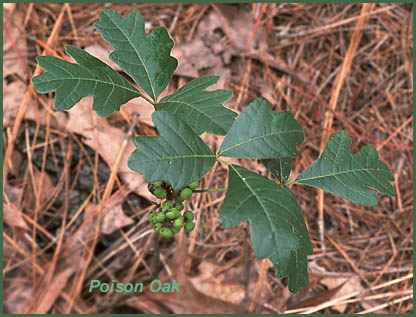Poison-Oak
Toxicodendron pubescens
Family: Anacardiaceae
Natural History

Poison-oak leaves showing the three leaflets with rounded lobes
Photo credit: SFRC, University of Florida
Poison-oak is a small, erect shrub that commonly grows up to 3 feet tall. It gets its common name from the compound leaves formed of three lobed leaflets that look like oak leaves. The plant is deciduous and the leaves turn red in the fall before they drop. Poison-oak spreads by sprouting from underground stems, called rhizomes, and by seeds. The sap in poison-oak contains a toxic substance, called urushiol, which can be harmful to susceptible people.
Poison-oak grows in dry ecosystems with sandy soils and poor nutrient availability such as sandhills, scrub, hardwoods, and other pinewood habitats. It is found from Florida, west to Texas, north to Kansas, and east to New Jersey; although it is most common along the coastal plain.
White-tailed deer and other small mammals browse on the leaves and its fruits. Many species of songbirds eat the fruits.
All parts of the poison-oak contain urushiol, an oleoresin and allergen, which causes inflammation, swelling, and itching in susceptible individuals. It can be picked up by touching any part of the plant. Historically, Native Americans used poison-oak sap to dye baskets. Today, poison-oak is sometimes used for arthritis pain.
